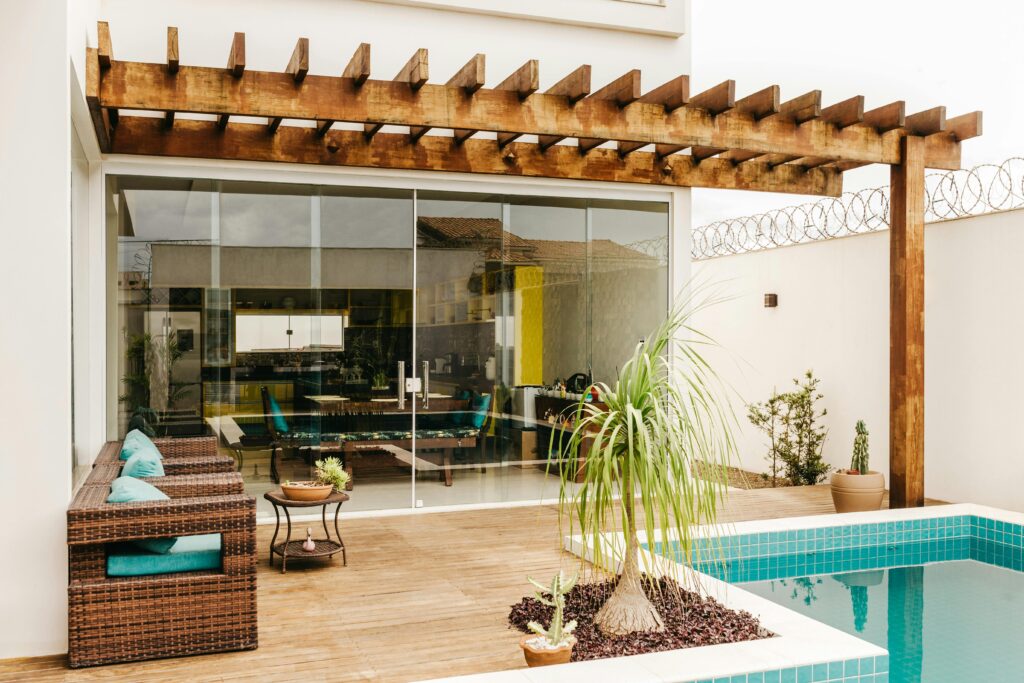Imagine stepping into your backyard on a warm summer evening, surrounded by lush greenery, natural materials, and the gentle hum of wildlife. Your terrace or patio isn’t just a beautiful extension of your home, it’s a thriving, eco-friendly oasis that nurtures the environment as much as it nurtures your soul. It sounds idyllic, but creating such a space requires more than just wishful thinking. That’s where sustainable solutions for terraces and patios come into play.
In this article, you’ll discover how to transform your outdoor living areas into ecological havens using innovative, sustainable solutions for terraces and patios. We will explore everything from choosing eco-friendly materials and incorporating native plants to water conservation techniques and energy-efficient lighting. Whether you’re a seasoned gardener, a DIY enthusiast, or someone just beginning to explore eco-conscious living, you’ll learn practical strategies to reduce your environmental footprint while enhancing the beauty and functionality of your outdoor space.
By the end of this read, you’ll be equipped with actionable ideas to create terraces and patios that aren’t just aesthetically pleasing but also contribute to a healthier planet. Say goodbye to wasteful design and hello to smart, sustainable choices that make your outdoor areas truly green. Ready to dive in? Let’s explore the best sustainable solutions for terraces and patios to help you cultivate your own piece of paradise, responsibly.
Table of Contents
ToggleKey Takeaways
- Choose Sustainable Materials: Opt for reclaimed wood, bamboo, or recycled composites for decking and furniture.
- Select Native & Drought-Tolerant Plants: Reduce water use and support local wildlife with species adapted to your climate.
- Implement Water-Saving Techniques: Use rainwater harvesting, drip irrigation, and permeable paving to minimize runoff.
- Incorporate Solar Lighting: Illuminate your outdoor space with solar-powered fixtures to cut energy costs and carbon footprint.
- Create Compost & Reduce Waste: Turn kitchen scraps and garden trimmings into nutrient-rich compost for healthy soil.
- Use Eco-Friendly Accessories: Look for recycled planters, non-toxic sealants, and multi-functional furniture to boost sustainability.
Why Sustainable Solutions for Eco-Friendly Terraces and Patios Matter More Than You Think
Creating terraces and patios that reflect a commitment to sustainability is no longer just a trend, it’s a necessity. Sustainable solutions for eco-friendly terraces and patios are essential in today’s world, where environmental concerns are at the forefront of many homeowners’ minds. But what exactly does this phrase mean, and why should you care about it when designing or renovating your outdoor space?
At its core, sustainable solutions for terraces and patios focus on reducing environmental impact while enhancing usability and aesthetic appeal. This involves the use of eco-conscious materials, energy-efficient designs, and plants that promote biodiversity. With urban spaces shrinking and climate change intensifying, integrating sustainable practices into your outdoor living area isn’t just good for the planet, it can improve your quality of life too.
Statistics underscore the urgency: according to the Environmental Protection Agency (EPA), outdoor spaces that incorporate native plants and permeable surfaces can reduce stormwater runoff by up to 90%, limiting pollution and erosion. Similarly, using recycled or sustainably sourced materials for decking and flooring decreases deforestation and landfill waste significantly. These benefits create a compelling case for adopting sustainable solutions for terraces and patios.
A great example is the community project in Portland, Oregon, where residents transformed a standard concrete backyard patio into an eco-friendly oasis. By incorporating reclaimed wood for decking, installing a rainwater harvesting system, and planting native shrubs and flowers, the community reduced water consumption by 40% and increased local pollinator habitats. This transformation not only beautified the neighborhood but also created measurable environmental benefits.
Understanding sustainable solutions for eco-friendly terraces and patios is vital for anyone looking to make an impactful, positive change in their home environment. By choosing greener options and smarter designs, you contribute to a healthier planet and enjoy a stunning, functional outdoor space that stands the test of time.
How to Implement Sustainable Solutions for Eco-Friendly Terraces and Patios Step by Step
Transforming your terrace or patio into an eco-friendly haven is not only beneficial for the environment but also enhances the beauty and functionality of your outdoor space. To help you achieve this, we’ve crafted a detailed, step-by-step guide on how to apply sustainable solutions for terraces and patios that truly make a difference.
Step 1: Assess Your Space and Set Clear Sustainability Goals
Before diving into materials and plants, take a close look at your terrace or patio. Understanding its size, orientation, sunlight exposure, and current state will guide your sustainable choices effectively.
– Measure the area to know how much material and how many plants you’ll need.
– Evaluate sunlight patterns to choose the right vegetation and shading options.
– Set sustainability goals , whether reducing water use, minimizing carbon footprint, or maximizing native plant integration.
A clear evaluation lets you tailor your solutions, ensuring they are both impactful and manageable.
Step 2: Choose Eco-Friendly Materials for Flooring and Furniture
The materials used in your terrace or patio can significantly influence its environmental impact. Opting for sustainable materials reduces waste, supports eco-conscious production, and often improves durability.
– Reclaimed wood or bamboo flooring: Both are renewable, have a lower carbon footprint, and add warm, natural textures.
– Recycled composite decking: Combines recycled plastics and wood fibers, requires low maintenance, and resists pests.
– Furniture made from recycled or sustainably sourced materials: Look for certifications like FSC (Forest Stewardship Council) or reclaimed metal frames.
– Eco-friendly sealants and paints: Use non-toxic, low-VOC (Volatile Organic Compounds) products to maintain air quality.
By carefully selecting your materials, you contribute to a sustainable cycle and ensure your terrace or patio ages gracefully.
Step 3: Integrate Native and Drought-Tolerant Plants
Plants are the heart of any eco-friendly terrace or patio. Choosing the right species can drastically reduce water consumption, attract local wildlife, and require minimal maintenance.
– Native species: These are adapted to your region’s climate and soil, making them hardy and beneficial for local ecosystems.
– Drought-tolerant plants: Succulents, lavender, sage, and ornamental grasses survive with less water and thrive in terraces exposed to sun.
– Vertical gardens or container plants: Maximize greenery without overwhelming your outdoor space.
Including a vibrant mix encourages biodiversity and crafts a serene, sustainable environment.
Step 4: Implement Water Conservation Techniques
Water is a precious resource that sustainable terraces should respect. Smart water management ensures your outdoor oasis stays lush without wasting water.
– Rainwater harvesting systems: Collect and store rainwater for irrigation, reducing reliance on municipal water.
– Drip irrigation and soaker hoses: Deliver water directly to plant roots, minimizing evaporation.
– Permeable surfaces: Installing permeable pavers or gravel allows rainwater to infiltrate the ground rather than run off.
These techniques create a closed-loop watering system that maintains plant health responsibly.
Step 5: Enhance Energy Efficiency and Reduce Waste
Beyond plants and materials, optimizing your terrace or patio’s energy use and minimizing waste supports overall sustainability.
– Solar-powered lighting: Use LED solar lights to illuminate your patio with zero electricity usage.
– Composting bins: Divert plant trimmings and organic kitchen waste into compost, enriching your soil naturally.
– Multi-functional furniture: Choose pieces that double as storage or seating to reduce unnecessary consumption.
These thoughtful additions round out your eco-friendly terrace, saving resources and lowering your carbon footprint.
In Summary
Applying sustainable solutions to terraces and patios is a rewarding endeavor that combines creativity with environmental responsibility. By following this step-by-step guide, you will reduce ecological impact, save resources, and create an inviting outdoor space that reflects your commitment to sustainability.
Remember, every small choice , from the plants you select to the materials you use , contributes to a greener future. Start today, and watch your eco-friendly terrace or patio flourish for years to come.
Tips for Creating Sustainable Solutions for Eco-Friendly Terraces and Patios:
✅ Use Reclaimed Wood: Opt for reclaimed or recycled wood materials to build decks and furniture. It reduces deforestation and adds rustic charm.
✅ Install Solar Lighting: Incorporate solar-powered lights to illuminate your space efficiently without increasing your electricity bill or carbon footprint.
✅ Choose Native Plants: Plant native species that require less water and maintenance, promoting local biodiversity and healthy ecosystems.
✅ Opt for Permeable Paving: Use permeable materials for patios and walkways to allow rainwater absorption, reducing runoff and improving groundwater recharge.
✅ Collect Rainwater: Set up rain barrels to collect water for irrigation, conserving municipal water and keeping your garden hydrated naturally.
✅ Use Eco-Friendly Furniture: Select outdoor furniture made from sustainable, non-toxic materials like bamboo or recycled metal for durability and environmental care.
✅ Create Compost Areas: Establish a compost bin nearby to recycle organic waste, enrich soil quality, and reduce landfill contributions.
✅ Incorporate Vertical Gardens: Maximize space and improve air quality by growing plants vertically using trellises or wall-mounted planters made from recycled materials.
These simple yet effective steps make your terrace or patio one step closer to being truly eco-friendly while enhancing beauty and functionality.

Key Concepts
When diving into the realm of sustainable solutions for eco-friendly terraces and patios, it’s essential to understand the foundational principles that shape these green outdoor spaces. Sustainability, in this context, isn’t merely a buzzword; it’s a holistic approach that intertwines ecology, design, and lifestyle. To truly appreciate what makes a terrace or patio sustainable, we must explore several key concepts, each one a thread that, when woven together, creates a vibrant tapestry of environmental harmony and function.
Sustainability: The Heartbeat of Eco-Friendly Outdoor Spaces
At the core lies sustainability, a concept that transcends simply using “green” materials or planting a few trees. Sustainability in terraces and patios means designing with respect for natural cycles, minimizing environmental impact, and fostering biodiversity. Imagine your outdoor space as a small ecosystem, a living organism where every element, from the choice of decking to the plants you cultivate, plays a role in maintaining balance and health.
Sustainability embodies a mindset that honors renewal and conservation. It’s akin to a gardener who picks only ripe fruits, ensuring the tree thrives season after season. Here, the philosophy extends beyond immediate aesthetics to consider longevity, resource efficiency, and the gentle footprint left on the planet.
Materials: The Silent Storytellers
Materials are the unsung heroes of sustainable terraces and patios. They tell the story of origin, transformation, and destiny. When we speak of sustainability, natural or recycled materials often come first to mind, yet the story is richer.
Imagine walking onto a patio made of reclaimed wood, the surface bearing the faint scars and textures of its past life, a barn door, a shipping crate, or an old pier. Each plank carries history while reducing demand for freshly harvested timber. This reuse symbolizes a cycle of rebirth intrinsic to ecological thinking.
Similarly, natural stone or terracotta tiles echo the earth from which they emerged, their durability a testament to nature’s resilience. When selected wisely, such materials require less maintenance, avoid harmful chemicals, and age gracefully, developing a patina that enhances their story rather than diminishing their value.
Water Management: Dancing with Nature’s Flow
Sustainability intimately involves how we understand and manage water, life’s most precious resource. A sustainable patio or terrace doesn’t fight the rain or ignore runoff; it becomes part of a larger hydrological dance.
Consider permeable pavers, clever solutions allowing water to seep into the ground, nourishing roots below instead of rushing away to the sewer system. This idea reflects an ancient rhythm where rainwater was a welcome visitor, not a foe to be repelled.
Rainwater harvesting systems add another layer of harmony, capturing fleeting drops to hydrate plants during dry spells. Through these measures, terraces and patios become entities that live in coexistence with nature’s ebb and flow, rather than against it.
Plant Selection: Gardens as Living Narratives
Plants in sustainable outdoor areas are more than decorative elements, they are living chapters in the eco-friendly story. Choosing native species or drought-resistant varieties is like casting ecological protagonists who know their roles well.
Native plants, adapted to local soil and climate, often require fewer resources and support indigenous wildlife. Their presence writes a rich narrative of place, connecting human design with the broader landscape. In contrast, exotic plants may demand extra water, fertilizers, or attention, pulling energy away from true sustainability.
This botanical cast contributes to habitats for pollinators, birds, and even beneficial insects, weaving biodiversity into the fabric of urban life. The terrace or patio thus transforms from a static space into a dynamic sanctuary, filled with the subtle hum of coexistence.
Energy Efficiency: More Than Just Lighting
Eco-friendly terraces and patios often integrate principles of energy efficiency, but this goes beyond ensuring LED lights illuminate the evening. It’s about harnessing natural elements to reduce energy consumption and create comfort organically.
Think of a pergola draped in climbing vines that filter sunlight, offering shade in summer and allowing warmth in winter. This natural modulation of temperature reduces reliance on artificial cooling or heating, making the space more in tune with climate variations.
Solar-powered features, whether lighting, water fountains, or small heaters, convert sunbeams into usable energy, a silent partner in sustainability. Through these energy-conscious choices, outdoor areas become thoughtful environments where human enjoyment meets responsibility.
Waste Reduction: Closing the Loop
Sustainability is condemned to failure if waste is ignored. In terraces and patios, this translates to approaches that minimize debris during construction and everyday maintenance.
Think of composting organic garden waste, turning fallen leaves and pruned branches into fertile soil. This circular process echoes the natural decay and regrowth cycles, preventing resources from becoming mere trash. Even small choices, like selecting modular furniture that can be repaired or repurposed, reflect a commitment to responsible consumption.
By viewing waste as a resource to be reintegrated, outdoor spaces embody a philosophy where nothing is truly lost, only transformed.
Aesthetic and Emotional Resonance: Sustainable Beauty
Finally, sustainable terraces and patios bridge the practical and the poetic. They remind us that green solutions need not sacrifice beauty or comfort. Rather, their aesthetics derive from native textures, natural colors, and organic forms, elements that soothe the senses and inspire mindfulness.
Imagine stepping into a terrace where the scent of lavender mingles with the warmth of sun-warmed stones, where the gentle trickle of a water feature blends with bird song. This sensory symphony evokes a deeper connection to the earth and reinforces the emotional value of sustainability.
In this sense, sustainable design is like composing a poem with the earth as muse, where every detail matters and every experience nurtures a sense of stewardship.
By weaving these key concepts together, the idea of sustainable solutions for eco-friendly terraces and patios emerges as a multifaceted philosophy rather than a single product or action. It’s a dance of respect for resources, celebration of nature’s wisdom, and thoughtful design that invites us to live lightly while rejoicing in the beauty of our outdoor spaces. Understanding these pillars enriches our appreciation and opens pathways to meaningful environmental harmony in our own backyards.
Frequently Asked Questions about Sustainable Solutions for Eco-Friendly Terraces and Patios
❓ What are sustainable solutions for terraces and patios?
Sustainable solutions for terraces and patios refer to eco-friendly materials, designs, and practices that minimize environmental impact while enhancing outdoor living spaces. These include using recycled or renewable materials, implementing water-efficient landscaping, and incorporating native plants.
❓ How can I make my patio more eco-friendly without a big budget?
You can start by using reclaimed wood for decking, installing rainwater harvesting systems, and choosing drought-resistant plants. Small changes like switching to LED outdoor lighting and avoiding chemical fertilizers also make a difference without costing much.
❓ Are sustainable terraces expensive to build and maintain?
While some sustainable materials might have a higher upfront cost, many eco-friendly options save money over time by reducing energy, water use, and maintenance needs. For example, permeable paving reduces runoff and lawn irrigation expenses, leading to long-term savings.
❓ Can I incorporate green roofs or vertical gardens on my terrace?
Absolutely! Green roofs and vertical gardens are excellent sustainable solutions that improve insulation, reduce heat, and create natural habitats. They also enhance air quality and add aesthetic value to your terrace or patio.
❓ What’s the best way to choose plants for an eco-friendly patio?
Opt for native and drought-tolerant plants that require less water and care. These plants adapt well to your local climate, support local wildlife, and reduce the need for chemical treatments, making your patio truly sustainable.
By focusing on these sustainable solutions for terraces and patios, you not only create beautiful outdoor spaces but also contribute positively to the environment.



One Response